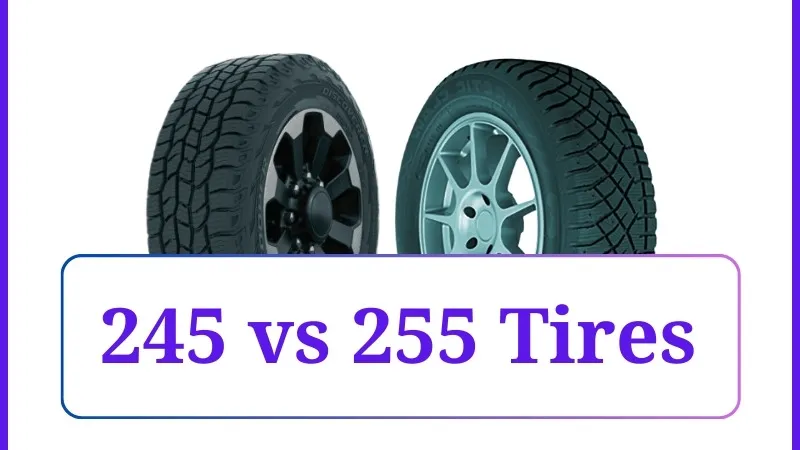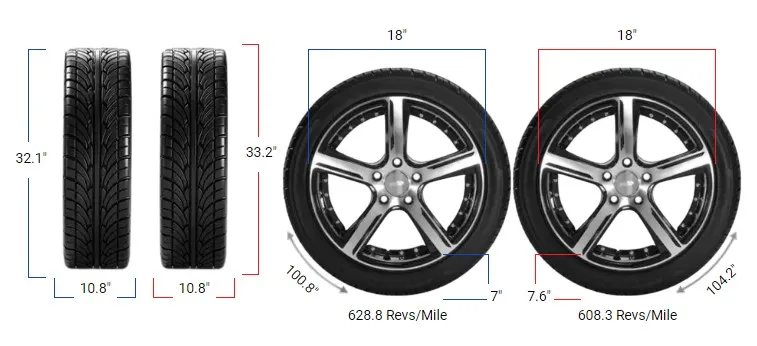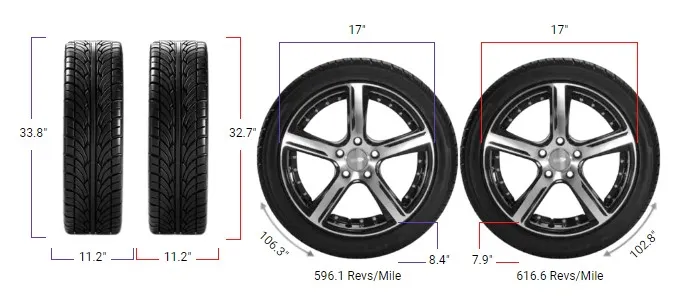245 vs 255 Tires

The main difference between 245 and 255 tires lies in their width. The 255 tires is about 10 mm wider than the 245 tires. A 245 tire is 245 millimeters wide, while a 255 tire is 255 millimeters wide.
Although this may seem like a minor difference, it can have a noticeable impact on traction, handling, and fuel efficiency. The 255 tire has a wider contact patch, which translates into better grip and stability, especially during cornering or driving in wet conditions.
This makes 255 tires a popular choice for those looking to enhance their vehicle’s performance. On the other hand, 245 tires provide a more balanced approach, offering adequate traction while being more fuel-efficient, which makes them a suitable option for daily driving.

Fitment Guide
Before deciding between 245 and 255 tires, it is essential to understand their fitment requirements. Below is the Ideal Rim Width Range for each tire size:
- 245 tire: Suitable for rims between 7.5 to 9.0 inches wide.
- 255 tire: Compatible with rims ranging from 8.0 to 9.5 inches wide.
The Ideal Rim Width Range should overlap for both sizes to ensure a proper fit. In this case, 245 and 255 tires are compatible with rims between 8.0 and 9.0 inches wide, making a swap feasible without changing your rims.
Also, the aspect ratio and rim diameter must remain the same, or the difference in overall diameter must be within 3% to maintain speedometer accuracy and vehicle safety.
If these conditions are not met, switching tire sizes could negatively impact your vehicle’s performance.

On-Road Performance
The 255 tire provides enhanced handling and stability due to its wider contact patch. This makes it a great choice for drivers who prioritize traction, especially during high-speed maneuvers or on winding roads. The additional width allows for greater surface contact, which results in improved grip during cornering, making the driving experience more confident and stable.
In contrast, 245 tires offer a balance between stability and ease of handling. Their slightly narrower profile reduces rolling resistance, resulting in a lighter steering feel and more agility, which is advantageous in urban driving or tight parking situations. For those who value maneuverability over maximum traction, 245 tires may be the better option.
Fuel Efficiency: One of the key benefits of 245 tires is their superior fuel efficiency. The narrower width produces less rolling resistance, which means the engine needs to exert less energy to maintain speed. This translates into better fuel economy, making 245 tires ideal for long commutes or anyone looking to reduce fuel costs.
Conversely, 255 tires offer improved grip but at the cost of slightly reduced fuel efficiency. The wider contact patch increases rolling resistance, which can result in higher fuel consumption. Drivers who prioritize performance and enhanced stability may find this trade-off worthwhile.

Ride Comfort: In terms of ride comfort, 245 tires typically provide a smoother experience, particularly for daily driving. The narrower width helps absorb road imperfections and minimizes road noise, making for a quieter and more comfortable ride. This is particularly appealing for those who prioritize a pleasant driving environment.
255 tires may provide a firmer ride due to the increased width and stiffer sidewalls, which can transmit more road surface vibrations into the cabin. However, the added stability and performance may be worth the slightly firmer ride for those who enjoy spirited driving or frequently drive on winding roads.
Off-Road Performance
For light off-road driving, 255 tires have the advantage due to their wider contact patch, which offers improved traction on loose surfaces such as gravel or sand.
The increased surface area provides better grip, making 255 tires a popular choice for drivers who occasionally venture off the beaten path.
245 tires, while capable of handling light off-road conditions, may not offer the same level of stability as 255 tires on loose terrain. Their narrower profile provides less flotation, which can make it more challenging to maintain control on softer surfaces
However, 245 tires are still suitable for those who primarily drive on-road but need occasional off-road capability.

Speedometer Impact
Switching between 245 and 255 tires can affect the accuracy of your vehicle’s speedometer and odometer readings.
A change in overall diameter can lead to discrepancies in speed and distance measurements. For example, if the 255 tire has a larger overall diameter than the 245 tire, the speedometer may underreport your actual speed.
To maintain accurate speed and distance readings, it may be necessary to recalibrate the speedometer if the overall diameter change exceeds 3%.
Proper recalibration ensures that your vehicle maintains reliable performance metrics and keeps you informed while driving.
Benefits of 255 Tires:
- Enhanced Traction and Stability: The wider contact area offers improved grip, especially during high-speed maneuvers and on winding roads.
- Sportier Appearance: 255 tires give vehicles a more aggressive and sporty look, which can be appealing for performance enthusiasts.
- Better Off-Road Capability: The increased width provides improved traction on loose surfaces, making 255 tires suitable for light off-road driving.
Drawbacks of 255 Tires:
- Lower Fuel Efficiency: The increased rolling resistance of 255 tires can lead to reduced fuel efficiency, particularly in city driving.
- Firmer Ride: The wider profile may contribute to a firmer ride, which can be less comfortable for those prioritizing a smooth driving experience.
Benefits of 245 Tires:
- Better Fuel Economy: The narrower width reduces rolling resistance, resulting in better fuel efficiency, making 245 tires ideal for long-distance driving.
- Easier Handling: The lighter steering effort makes 245 tires easier to maneuver, particularly in urban environments.
- Quieter Ride: The reduced contact patch helps minimize road noise, contributing to a quieter and more comfortable driving experience.
Drawbacks of 245 Tires:
- Limited Traction: Compared to 255 tires, 245 tires have a smaller contact area, which can reduce traction, especially in wet or challenging road conditions.
- Less Aggressive Appearance: 245 tires may not provide the same bold look as wider 255 tires, which can be important for those seeking a sportier aesthetic.
Our Observation
Selecting between 245 and 255 tires requires weighing the trade-offs in terms of traction, handling, comfort, and fuel efficiency.
245 tires are a great choice for drivers seeking practicality and comfort, while 255 tires cater to those who prioritize enhanced performance and a more aggressive look.
Always consult a tire professional to ensure that the tire size you choose is compatible with your vehicle and suited to your driving needs.



